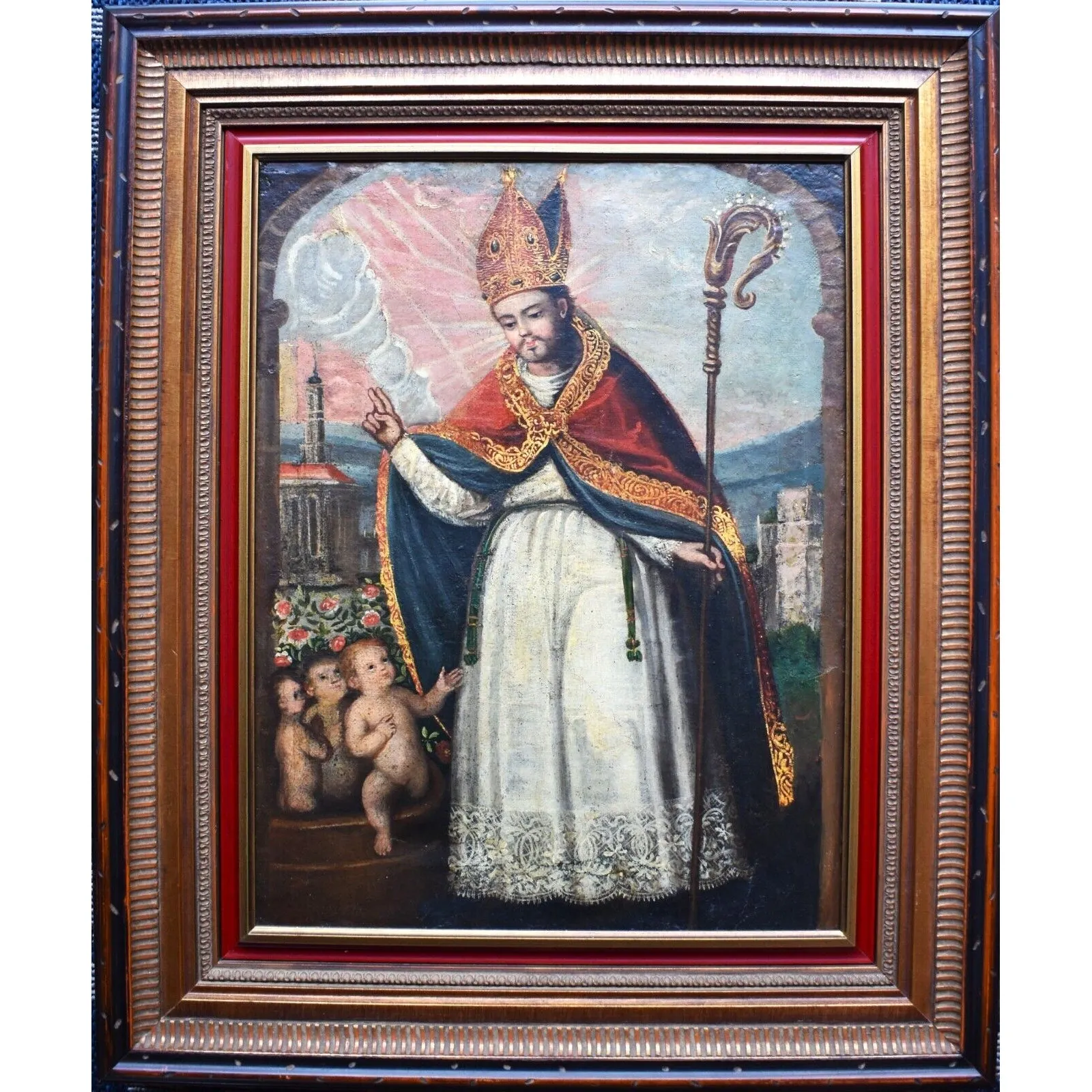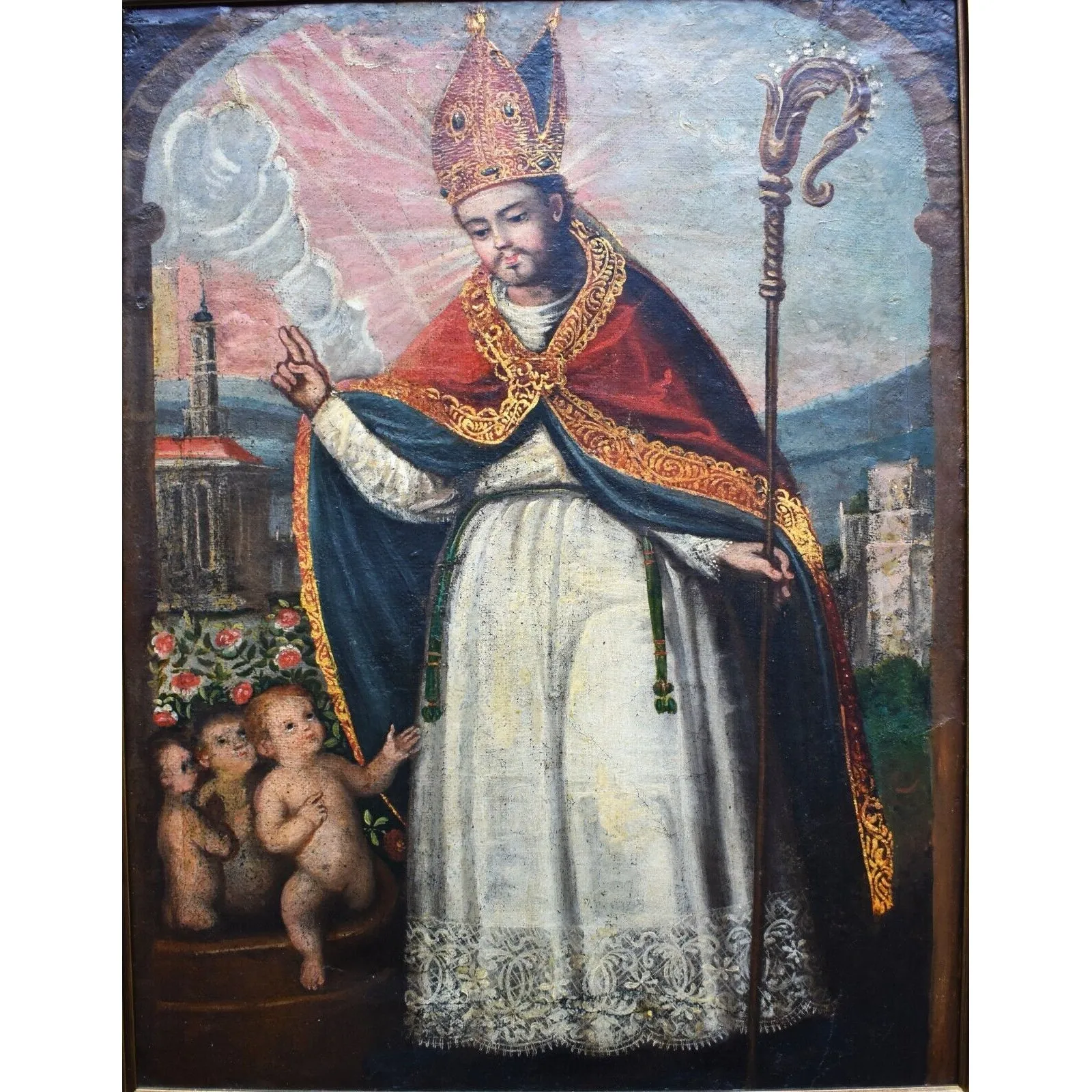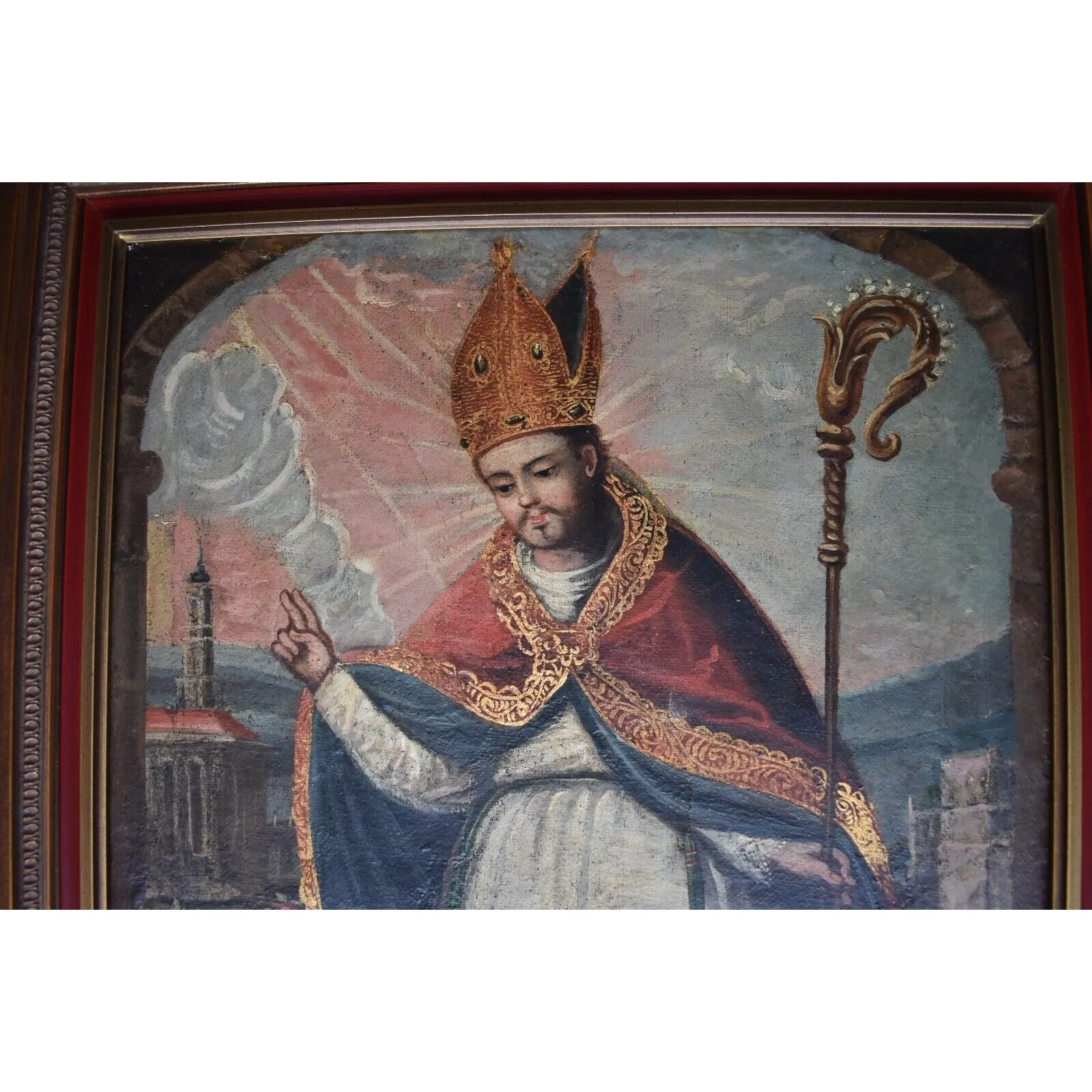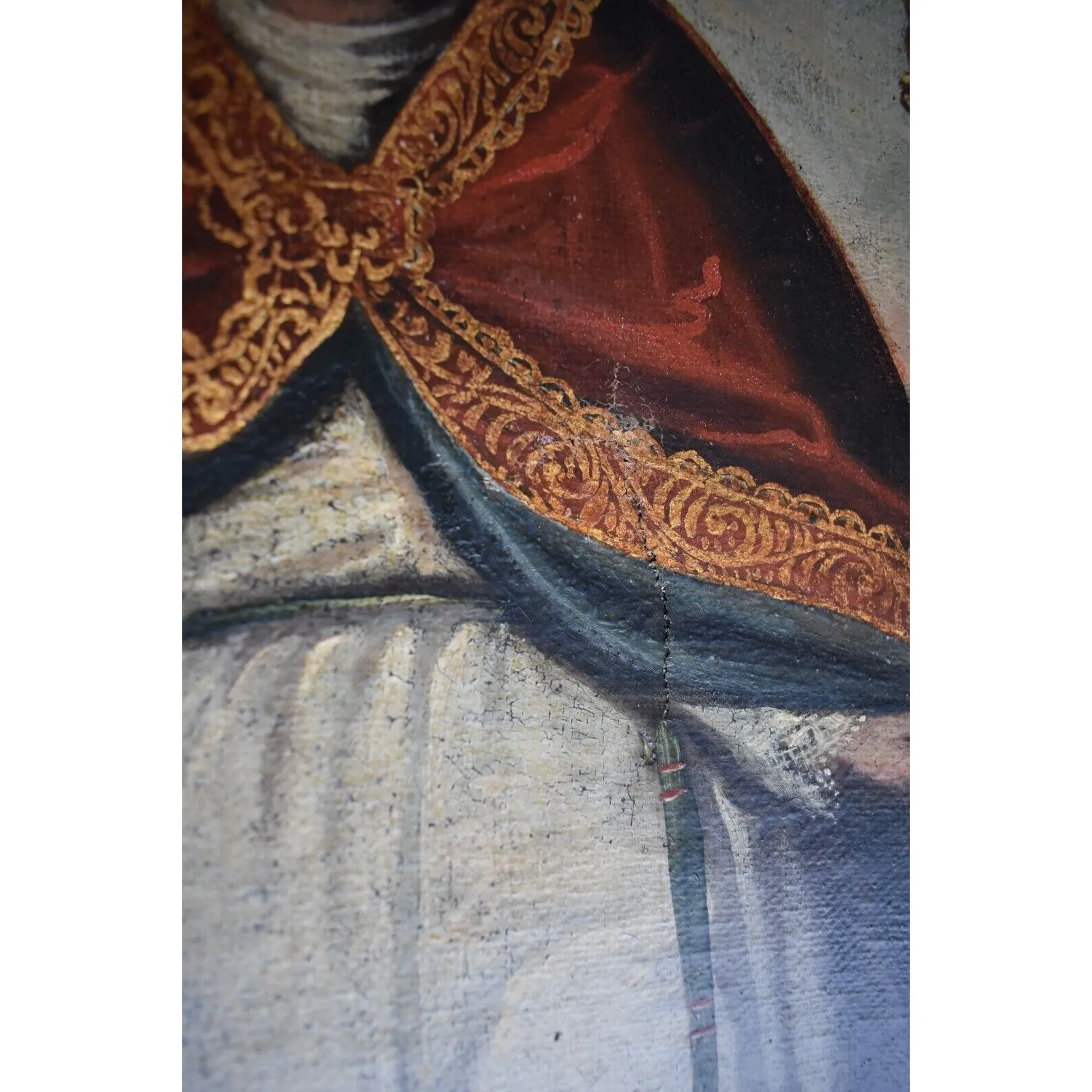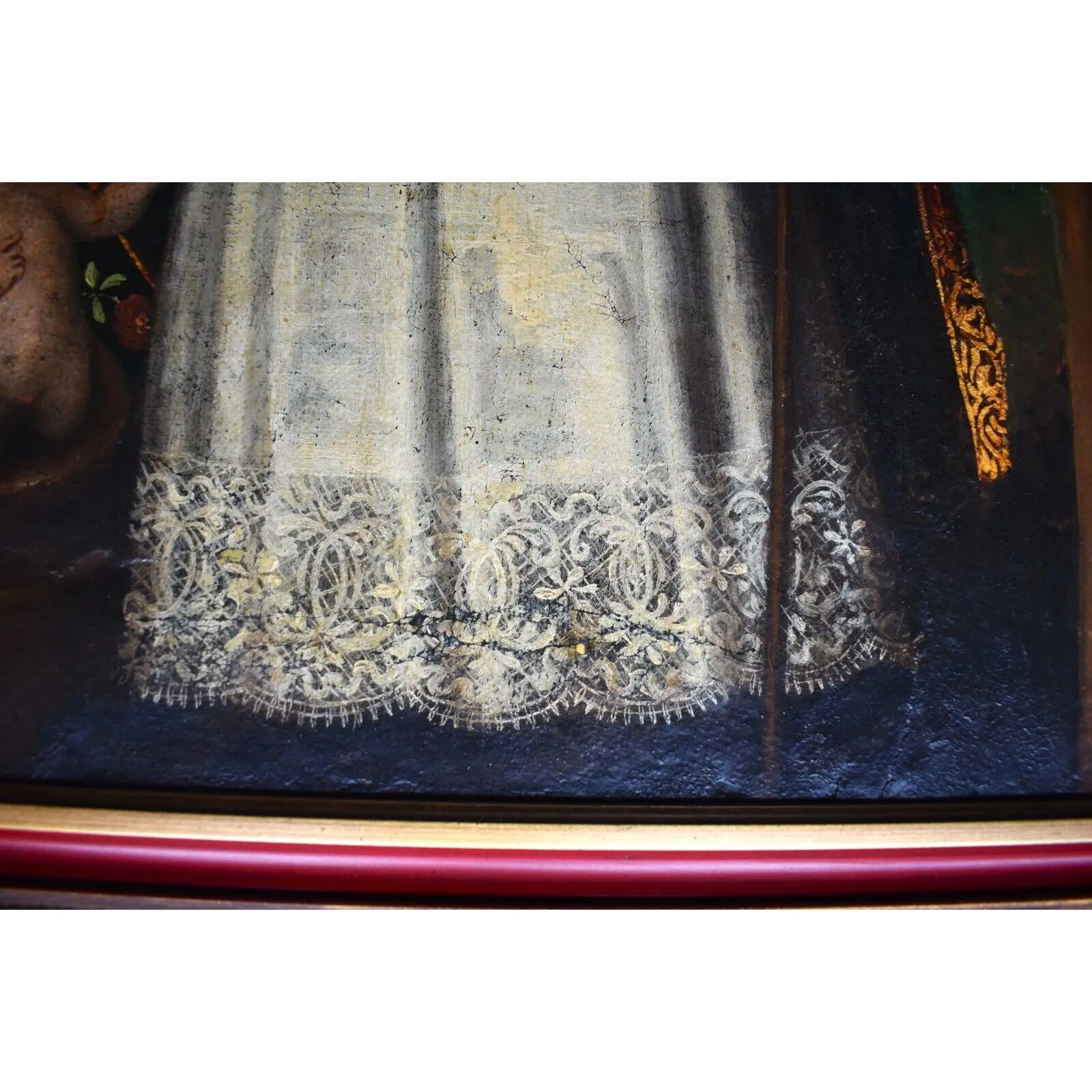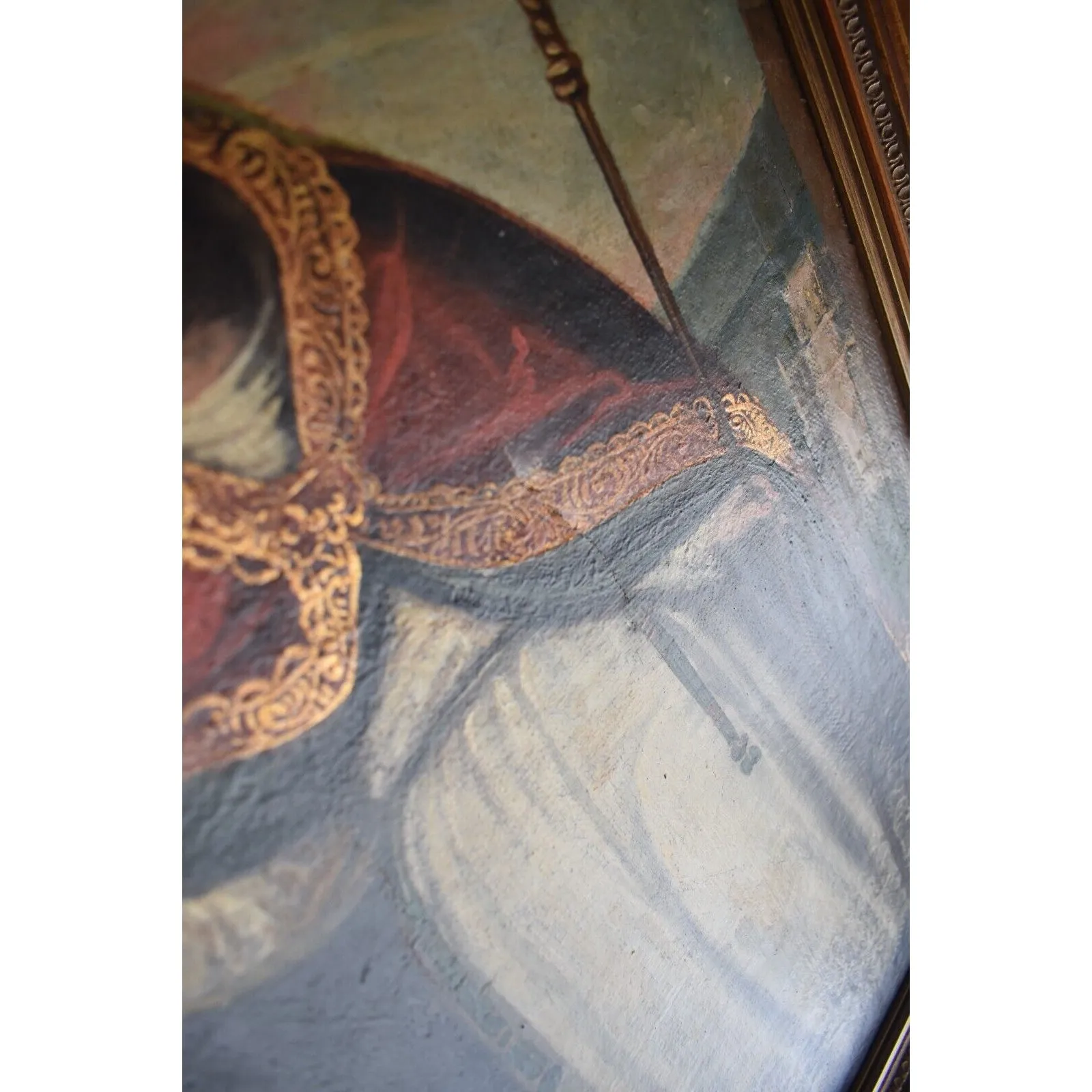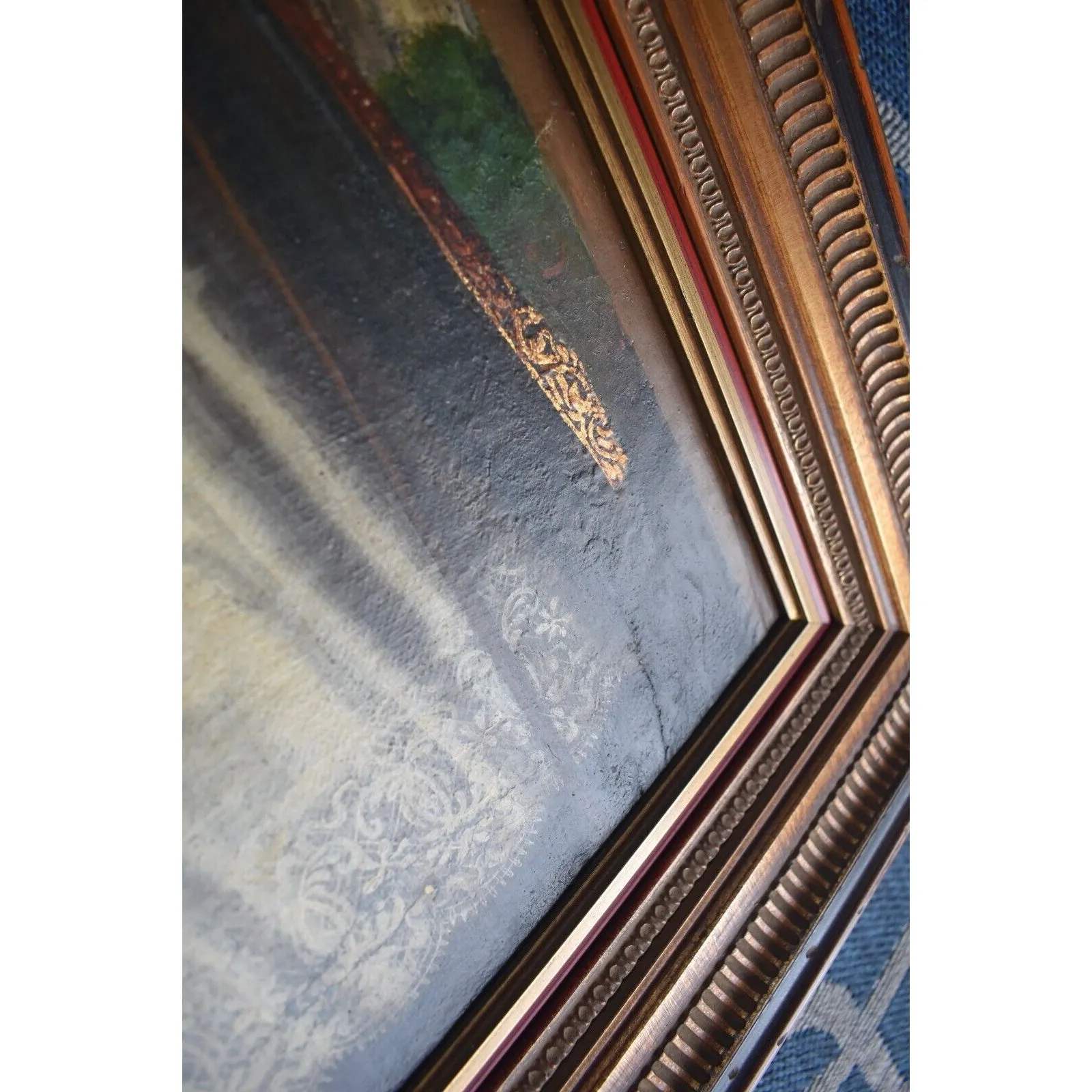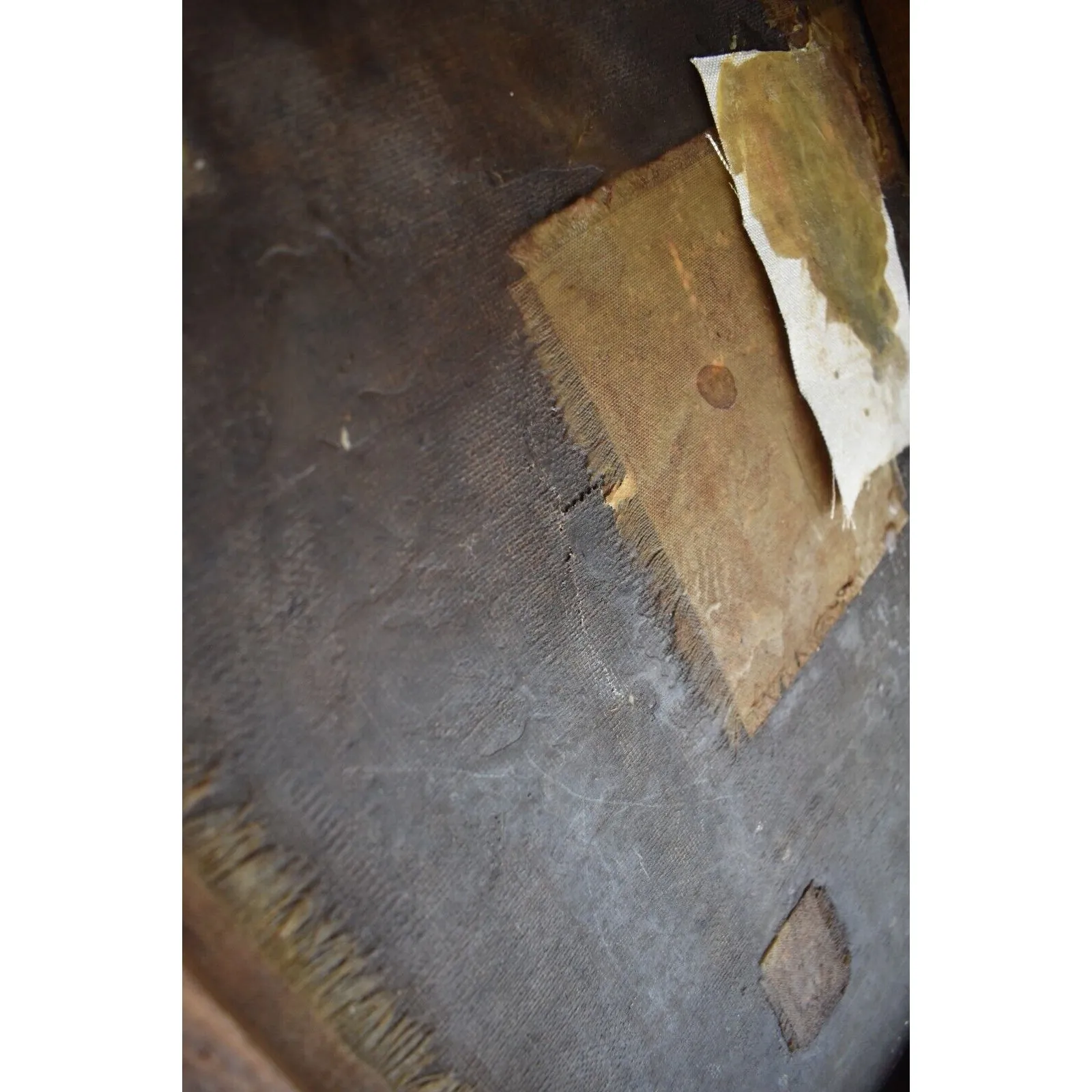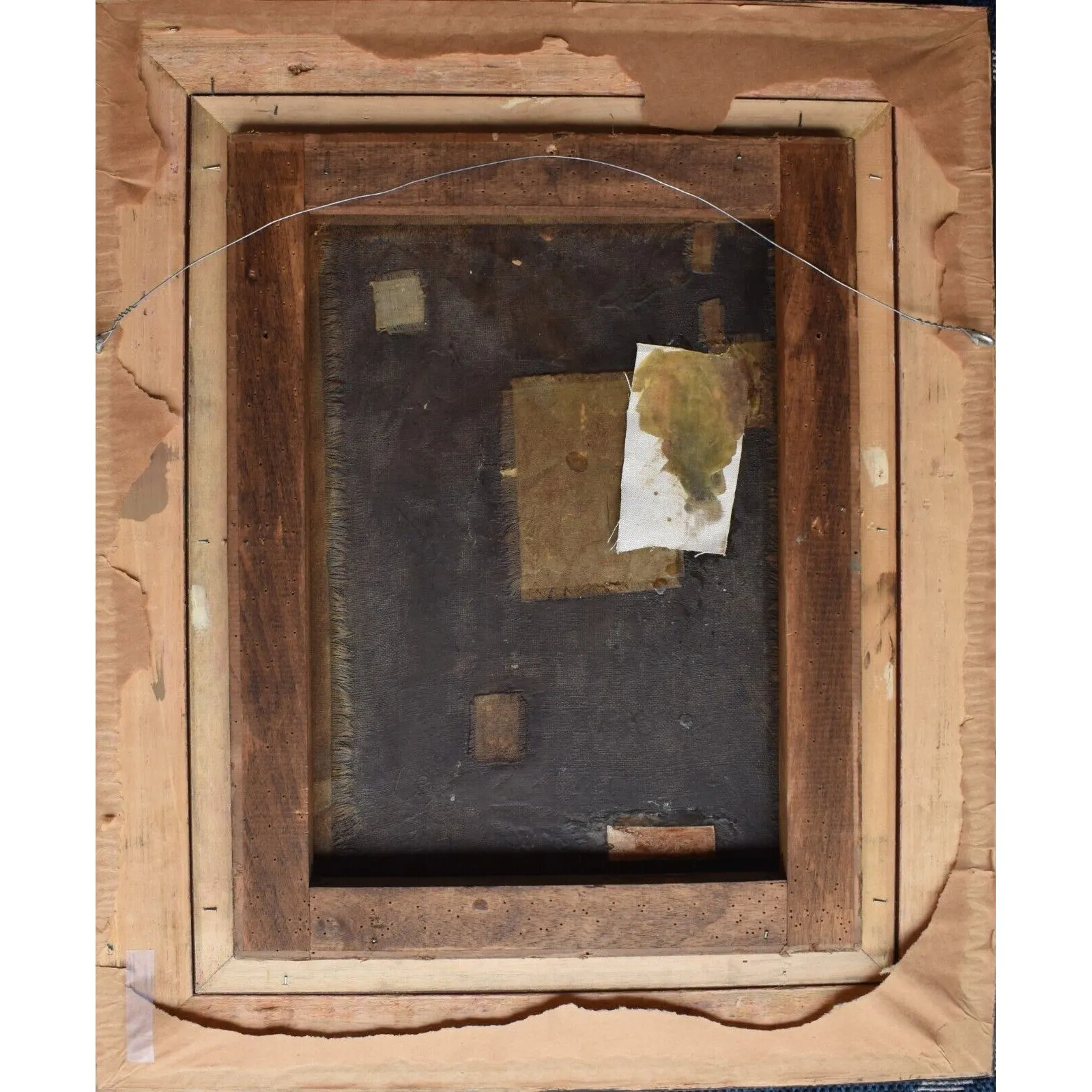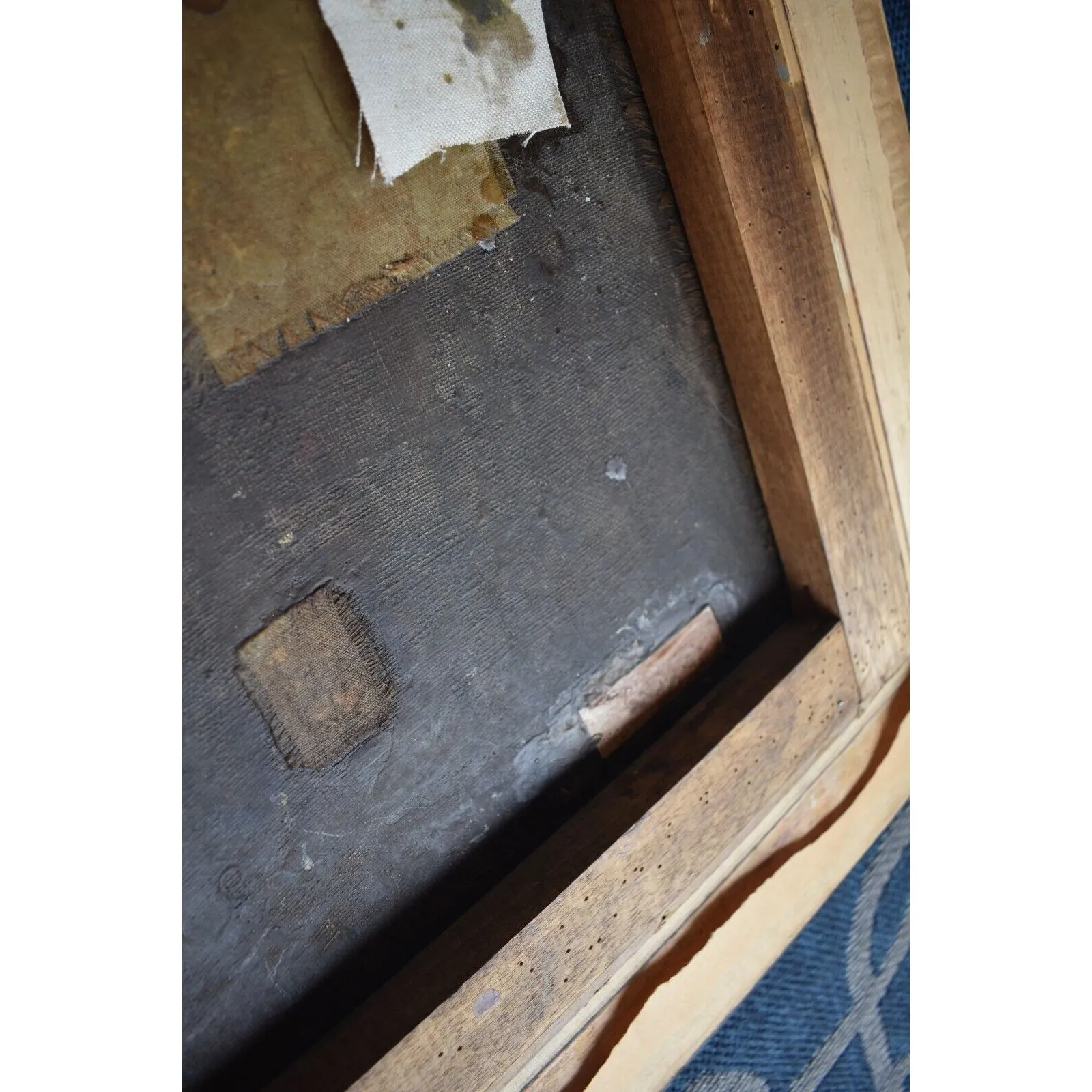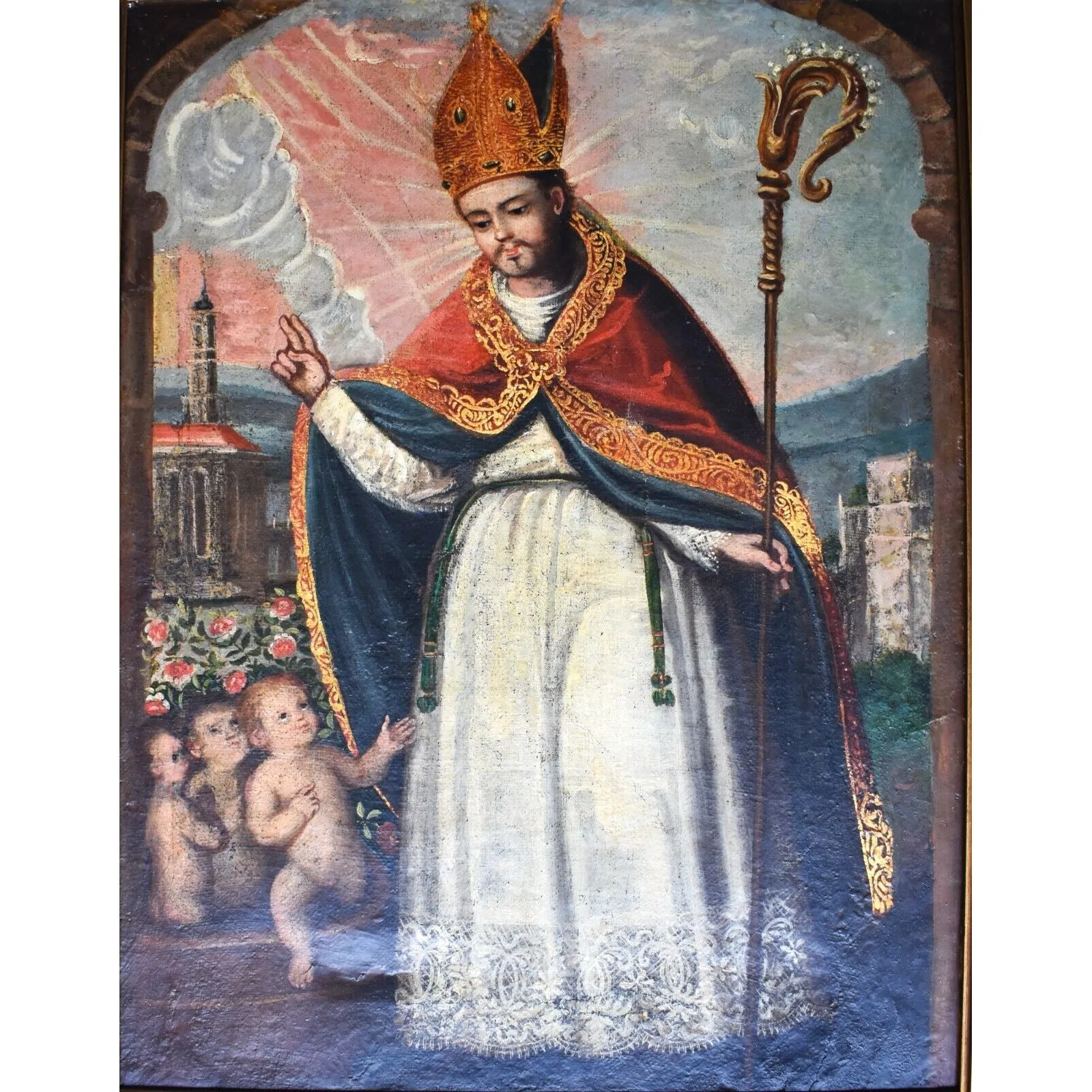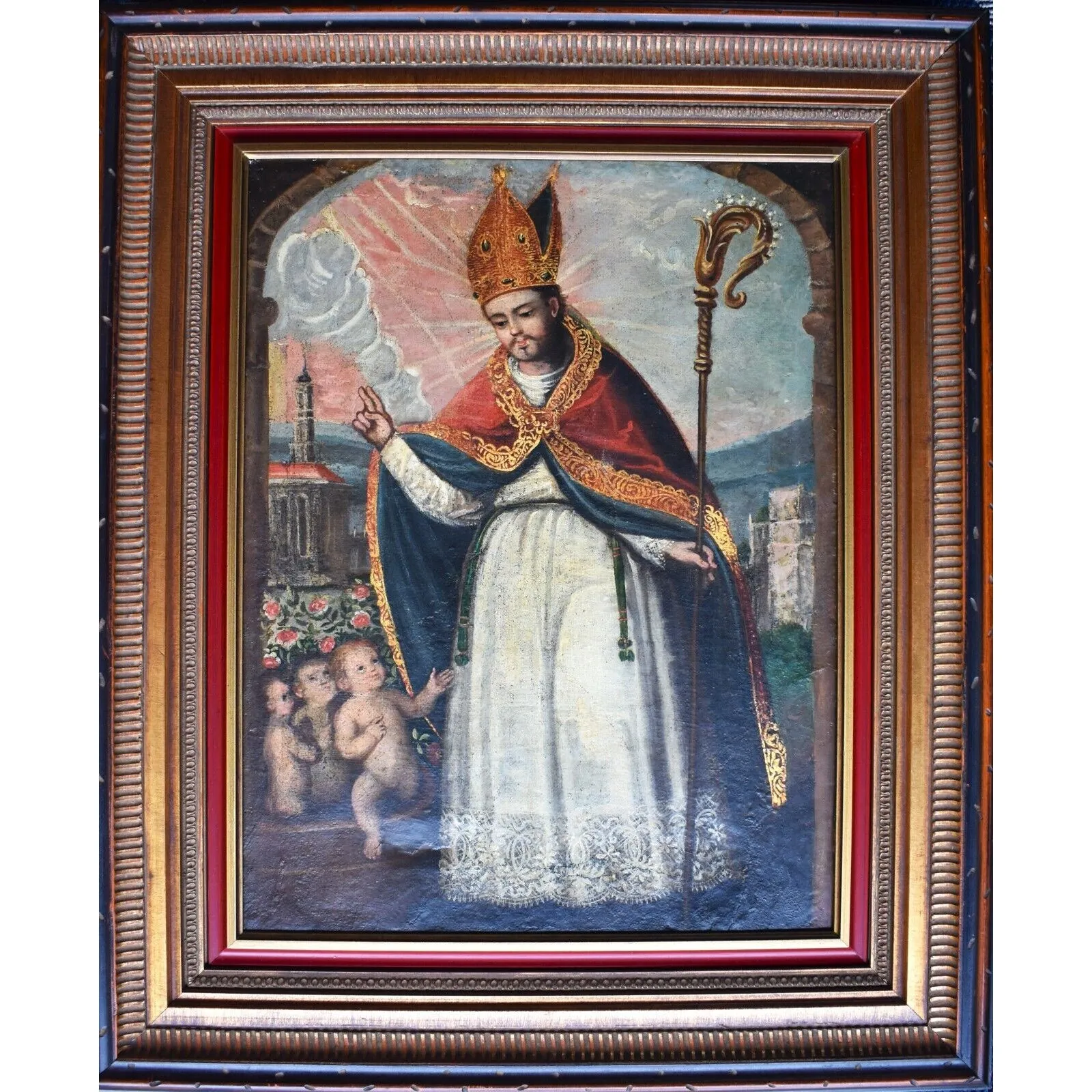- Saint Nicholas San Nicolas Antique 19th C. Spanish Colonial Painting on Canvas/ Retablo
- Beautiful framed 18th-19th century, Spanish Colonial religious oil painting on canvas.
- The painting is framed (in a heavy newer gilt wood frame) and in very good condition. Crackelure, scratches, old repairs, approximately 2" tear(above right tassel), as evidenced in the photos. Please forgive the bluish glare in some of the photos. Image depicts San Nicolas de Bari giving a Benediction over 3 small Children. He holds a Crosier in his left hand.
- Measurements: 16"w x 21"h (view), 24"w x 29 1/2"h (framed)
- Condition: Damage that is visible in photos may not be noted in description. Unless noted NO damage, all items have some amount of acceptable wear, scratches, nicks, missing stitches, etc. for their age.
- The Evil Butcher
When it was late and the sun going down, the children were hungry, tired and lost. They came to a lighted butcher's shop, knocked and said, "We are lost and hungry. May we eat and sleep?" "Oh, yes," came the reply, "do come in."
As they enter, the butcher takes a sharp knife, cuts them up, and puts them in a large salting tub. Seven years pass.
A knock comes on the door. Bishop Saint Nicholas appears, saying to the evil butcher, "Open your large salting tub!" The saint puts his hand on the tub and, appealing to God, says, "Rise up, children." The little children awake and stand up. Their families joyfully welcome them home.
- Ever since St. Nicholas has been the patron and protector of children.
NOTE
The older, original version of this story is about three students traveling away to school. They stopped in an inn and were drugged, robbed, and murdered. Over the years, especially in France and Western Europe, these grown male students came to be seen as little children. Sometimes it is an evil innkeeper, other times an evil butcher that does them in. In France the evil butcher became St. Nicholas servant and has followed him ever since. This is the most popular story in France, set to a well-known and beloved song. The image of Saint Nicholas with children in a tub at his feet is the most widespread image of the saint in Western Europe. - In Savoie, People indeed call him Chalande, in Burgundy Père Janvier, in the Pays Basque Olentzaro and in Normandy Barbassionné.
St Nicholas - Santa - Pere Noel
Delivering a letter to Santa!
We all know that Père Noël has a round belly, a long white beard and a red coat with white fur trim.
However, everyone agrees that he lives at the North Pole and arrives on a flying sleigh pulled by eight reindeer.
St Nicholas tradition indeed originated in Scandinavia, then later spread throughout Europe and the continents.
The Dutch, who landed in New-York in the 17th century, indeed brought with them the legend of Sinter Klaas, the American Santa Claus.
Amazingly, Père Noël’s traditional round-bellied and white beard date only from the early 20th century.
He indeed adopted his trademark image from Julenisse, the Nordic elf who was represented with a white beard, a hat and fur clothes.
Julenisse brought gifts to the children for the mid winter celebrations or Midtvinterblot.
Père Noël is also a reminiscence of the Celtic god Gargan and the Viking Odin; both visited earth on the Winter solstice in order to distribute gifts to the children.
Santa’s reindeer
The reindeer, however, appeared in 1823 after the popularity of A Visit from St. Nicholas, a poem attributed either to Clement Clarke Moore or Henry Livingston Jr.
Their names are Dasher, Dancer, Prancer, Vixen, Comet, Cupid, Donder (or Donner) and Blitzen.
Rudolph (and his red nose) appeared with the song Rudolph the Red-Nosed Reindeer, a song written in 1939 by Johnny Marks.
French Père Fouettard and Père Noël
We all wrote a letter to Santa – Père Noël, telling him how good we were during the year!
We knew that he would come down our chimney on the night of December 24 and put presents in the socks we (children and parents) placed on the mantelpiece.
In the French tradition, Père Noël initially had a companion known as Père Fouettard.
However, this scary character whipped children who had misbehaved during the year!
That was not really good, so Père Fouettard was made to disappear a long time ago.
St Nicholas of Myra and Bari
Is Santa – Père Noël real or a product of our imagination?
The Church of Rome, once more, hijacked the pagan myth and intermingled it with the story St Nicolas of Myra (4th century).
St Nicholas - Santa - Pere Noel
St Nicolas was born in an affluent Christian family and lived in the Roman city of Patara, north of Bethlehem.
He was also the bishop of Smyrna (the present city of Izmir in Turkey), which was then part of the vast Roman Eastern Empire.
His relics were kept in Smyrna until the 6th century and were regarded as miraculous because of the “sacred oil” they produced.
However, Italian sailors from Bari stole them on May 9, 1087.
They brought them back home, where a basilica was especially built in order to house the precious relics.
St Nicolas has since also been known as St-Nicholas of Bari.
The Cathedral of Bari sold some fragments of relics to St Nicholas de Port Basilica in Lorraine in 1087.
St Nicholas has therefore become the patron saint of the Lorraine region (Eastern France), where he is still widely celebrated on December 6.
St. Nicholas’ miracles and legends
The Church of Rome attributes many miracles to St Nicholas, who was known for his faith and charity.
According to a first legend, Bishop Nicolas was a very wealthy and generous man.
He indeed spent his entire fortune buying presents for the poor children of his diocese.
He then distributed them… by throwing them through their windows.
St Nicholas - Santa - Pere Noel
This is where you post your letter to Santa
The second legend is quite gruesome.
It tells how the holy man resurrected three children who stopped at a butcher’s shop and were killed, cut into pieces and salted!
Seven years later Bishop Nicholas stopped over at the butcher’s and ordered meat he salted seven years earlier.
The butcher fled and the holy man brought the children back to life!
As a result, St Nicholas is the patron saint of children … and butchers! In the early 20th century, the symbolism of the butcher was transferred to the Père Fouettard.
This frightening character was indeed forced to accompany the Père Noël in his rounds as penance for his misdeeds!
Finally, a third and much nicer legend relates how St Nicholas gave money to a poor young woman who couldn’t afford a dowry.
He indeed threw a first bag of gold in her house while she slept, then a second bag the following night.
The girl’s father, intrigued by such generosity, mounted guard and caught Nicholas, as he was throwing a third bag through the chimney.
Does this ring a bell?!
Nicholas begged him to keep the secret, however, the word got out of course!
After Nicholas’ death, on December 6, wealthy people kept the tradition alive.
They anonymously gave presents to the paupers, who soon believed that the spirit of the generous St. Nicholas had come back.
Similarities between St Nicholas and Père Noël
Bishop Nicholas traveled by donkey, the Père Noël on a sleigh pulled by reindeer.
St Nicholas had a long white beard and wore a miter and a bishop’s amaranth red coat.
The Père Noël has the same long white beard and wears a large red coat with a hood with a fur trim.
In some parts of France, children place a glass of wine for St Nicholas and a carrot for his donkey under the Christmas tree.
In other regions they place a glass of milk for the Père Noël and a carrot for the reindeer!
Père Noël at Christmas
The Roman Catholic Church associated St Nicholas with the celebration of Christmas – Nativity of Jesus.
It therefore transferred St Nicholas’ Day celebration to December 25.
Père Noël, the round-bellied old man with a white beard has become the iconic symbol of Christmas.
However, St Nicolas is still celebrated on December 6 in Northern and Eastern France, but not in the rest of the country (to my knowledge).




